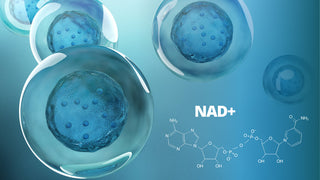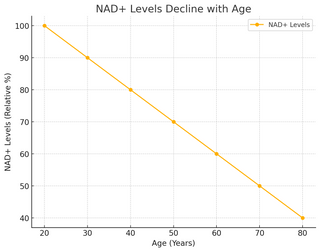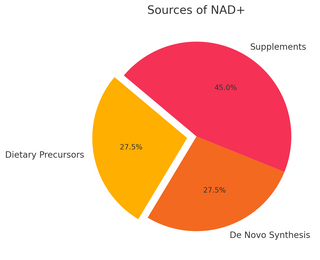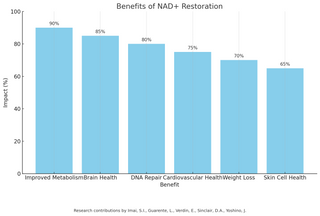

NAD+ Research
Research Report on NAD+
Introduction
Nicotinamide adenine dinucleotide (NAD+) is a crucial coenzyme found in all living cells. It plays an essential role in redox reactions, transferring electrons from one reaction to another, which is fundamental to cellular energy production. Beyond its metabolic functions, NAD+ is pivotal in regulating biological processes such as DNA repair, gene expression, and cellular signaling. In recent years, NAD+ has garnered significant attention for its potential role in aging and disease.

Chemical Structure and Function
NAD+ is composed of two nucleotides, one containing an adenine base and the other a nicotinamide. The molecule exists in two forms: NAD+ (oxidized) and NADH (reduced). It serves as a coenzyme in metabolic pathways, such as glycolysis, the tricarboxylic acid cycle, and oxidative phosphorylation, facilitating the production of ATP. Additionally, NAD+ is a substrate for enzymes like sirtuins, poly(ADP-ribose) polymerases (PARPs), and cyclic ADP-ribose synthases, which are involved in critical cellular functions beyond metabolism.

NAD+ and Aging
NAD+ levels decline with age in various tissues. This reduction is associated with impaired mitochondrial function, increased oxidative stress, and decreased activity of NAD+-dependent enzymes like sirtuins, which regulate cellular health and longevity. Enhancing NAD+ levels has been shown to mitigate age-related functional decline in preclinical studies, suggesting potential therapeutic applications for aging and age-related diseases.
Therapeutic Potential of NAD+
- Metabolic Disorders: NAD+ supplementation has demonstrated benefits in metabolic conditions such as obesity and type 2 diabetes. It enhances mitochondrial function and improves insulin sensitivity in preclinical models.
- Neurodegenerative Diseases: NAD+ depletion is linked to neurodegenerative disorders like Alzheimer’s and Parkinson’s diseases. Restoring NAD+ levels can protect neurons, reduce inflammation, and enhance cognitive function in animal studies.
- DNA Repair and Cancer: NAD+ is vital for the activity of PARPs, enzymes involved in DNA repair. While this makes NAD+ restoration beneficial for maintaining genomic stability, it also raises concerns in cancer therapy, where PARP inhibitors are used to target tumor cells. The relationship between NAD+ and cancer remains an area of active research.
- Cardiovascular Health: NAD+ influences cardiovascular health by improving endothelial function, reducing inflammation, and enhancing mitochondrial efficiency. Studies suggest that boosting NAD+ levels can protect against heart failure and ischemic injuries.
- Weight Loss: NAD+ restoration has been associated with improved metabolic function, which can support weight loss by enhancing energy expenditure, improving insulin sensitivity, and optimizing fat metabolism.

Sources and Supplementation
- Dietary Precursors: NAD+ can be synthesized from tryptophan through the de novo pathway or from dietary precursors like nicotinamide (NAM), nicotinic acid (NA), and nicotinamide riboside (NR).
- Supplementation:
- Nicotinamide Riboside Chloride (NRC): A precursor that effectively boosts NAD+ levels and has demonstrated safety and efficacy in human studies.
- Nicotinamide Mononucleotide (NMN): Another precursor showing promise in preclinical and early clinical studies for its role in enhancing NAD+ levels and improving metabolic and cardiovascular health.
- NAD+: While direct supplementation may be less common, research suggests it can significantly boost cellular NAD+ levels, making it a promising option worth considering.
- NRC and NMN: Both have been shown to increase NMN and NAD+ levels, making them valuable tools in addressing age-related NAD+ decline.
4. Lifestyle Interventions: Interventions like caloric restriction, exercise, and fasting have been shown to naturally increase NAD+ levels, enhancing overall cellular health.
Safety and Side Effects
While NAD+ precursors are generally well-tolerated, long-term effects are not fully understood. Some individuals may experience mild side effects such as nausea, fatigue, or gastrointestinal discomfort. It is essential to conduct more extensive clinical trials to establish safety profiles for chronic use.
Future Directions
The therapeutic potential of NAD+ is vast but requires further research to:
- Understand its role in complex diseases.
- Optimize dosing and delivery methods for supplementation.
- Evaluate long-term safety and efficacy in diverse populations.
Conclusion
NAD+ is a cornerstone of cellular metabolism and a promising target for therapeutic interventions in aging and chronic diseases. While current research highlights its potential, rigorous clinical trials are needed to translate these findings into practical medical applications. Boosting NAD+ levels through supplementation, lifestyle modifications, or novel therapeutics could revolutionize approaches to healthspan and lifespan extension.
References
- Imai, S. I., & Guarente, L. (2014). NAD+ and sirtuins in aging and disease. Trends in Cell Biology, 24(8), 464-471.
- Verdin, E. (2015). NAD+ in aging, metabolism, and neurodegeneration. Science, 350(6265), 1208-1213.
- Rajman, L., Chwalek, K., & Sinclair, D. A. (2018). Therapeutic potential of NAD-boosting molecules: The in vivo evidence. Cell Metabolism, 27(3), 529-547.
- Yaku, K., Okabe, K., & Nakagawa, T. (2018). NAD metabolism: Implications in aging and longevity. Ageing Research Reviews, 47, 1-17.
- Yoshino, J., Baur, J. A., & Imai, S. I. (2018). NAD+ intermediates: The biology and therapeutic potential of NMN and NR. Cell Metabolism, 27(3), 513-528.
